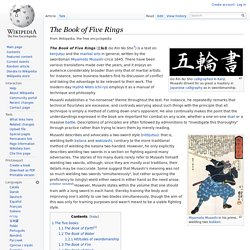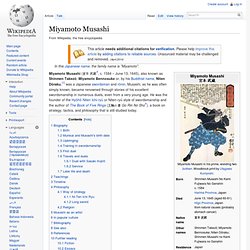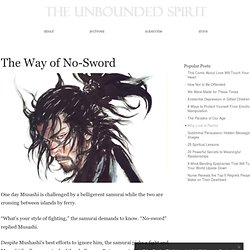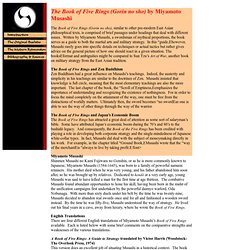

Samurai - Miyamoto Musashi Documentary (Mark Dacascos) The Legend of Samurai Warrior Miyamoto Musashi (Full Documentary) The Way of No Sword. Miyamoto Musashi - "Go Rin No Sho" - A Book of Five Rings by Miyamoto Musashi. By Miyamoto Musashi I have been many years training in the Way of strategy, called Ni Ten Ichi Ryu, and now I think I will explain it in writing for the first time.

It is now during the first ten days of the tenth month in the twentieth year of Kanei (1645). I have climbed mountain Iwato of Higo in Kyushu to pay homage to heaven, pray to Kwannon, [God(dess) of mercy in Buddhism. - Slaegr] and kneel before Buddha. I am a warrior of Harima province, Shinmen Musashi No Kami Fujiwara No Genshin, age sixty years. From youth my heart has been inclined toward the Way of strategy. After that I went from province to province dueling with strategist of various schools, and not once failed to win even though I had as many as sixty encounters.
When I reached thirty I looked back on my past. Since then I have lived without following any particular Way. Strategy is the craft of the warrior. There are various Ways. The Way of Strategy If we look at the world we see arts for sale. The Book of Five Rings. The Book of Five Rings (五輪書, Go Rin No Sho?)

Is a text on kenjutsu and the martial arts in general, written by the swordsman Miyamoto Musashi circa 1645. There have been various translations made over the years, and it enjoys an audience considerably broader than only that of martial artists: for instance, some business leaders find its discussion of conflict and taking the advantage to be relevant to their work. The modern-day Hyōhō Niten Ichi-ryū employs it as a manual of technique and philosophy. Musashi establishes a "no-nonsense" theme throughout the text. For instance, he repeatedly remarks that technical flourishes are excessive, and contrasts worrying about such things with the principle that all technique is simply a method of cutting down one's opponent. Musashi describes and advocates a two-sword style (nitōjutsu): that is, wielding both katana and wakizashi, contrary to the more traditional method of wielding the katana two-handed. The five books[edit] Miyamoto Musashi Quotes (Author of A Book of Five Rings)
Miyamoto Musashi. Miyamoto Musashi (宮本 武蔵?

, c. 1584 – June 13, 1645), also known as Shinmen Takezō, Miyamoto Bennosuke or, by his Buddhist name, Niten Dōraku,[1] was a Japanese swordsman and rōnin. Musashi, as he was often simply known, became renowned through stories of his excellent swordsmanship in numerous duels, even from a very young age. The Way of No-Sword. One day Musashi is challenged by a belligerent samurai while the two are crossing between islands by ferry.

“What’s your style of fighting,” the samurai demands to know. “No-sword” replied Musashi. Despite Mushashi’s best efforts to ignore him, the samurai picks a fight and Musashi finally agrees to duel the challenger. But, suggests Musashi, rather than fight on the cramped ferry, they should instead fight on that sandbar the ferry is approaching. The challenger quickly agrees and leaps overboars as the ferry passes the sandbar.
Landing on the sandbar, the samurai whirls, sword at the ready–only to watch the ferry continue on toward the far shore–a, smiling, waving Musashi still on board! Hours later, drenched in humiliation and dripping rage, the challenger finally wades ashore where he finds Musashi patiently fishing out of a small rowboat. “You tricked me!” Intra-navbar.gif. The Book of Five Rings (Gorin no sho) by Miyamoto Musashi The Book of Five Rings (Gorin no sho), similar to other pre-modern East Asian philosophical texts, is comprised of brief passages under headings that deal with different issues.

Written by Miyamoto Musashi, a swordsman of mythical proportions, the book serves as a guide to both the martial arts and military strategy. In this “guide,Ehowever, Musashi rarely goes into specific details on techniques or actual tactics but rather gives advice on the general picture of how one should react in a given situation. The booksEformat and ambiguities might be compared to Sun Tzu’s Art of War, another book on military strategy from the East Asian tradition. The Book of Five Rings and Zen Buddhism Zen Buddhism had a great influence on Musashi’s teachings. Technique 4/10 - Miyamoto Musashi's Niten Ichi Ryu. Technique 5/10 - Miyamoto Musashi's Niten Ichi Ryu.
Technique 6/10 - Miyamoto Musashi's Niten Ichi Ryu. Technique 7/10 - Miyamoto Musashi's Niten Ichi Ryu. Technique 8/10 - Miyamoto Musashi's Niten Ichi Ryu. Technique 9/10 - Miyamoto Musashi's Niten Ichi Ryu. Technique 10/10 - Miyamoto Musashi's Niten Ichi Ryu. Learning Musashi Miyamoto's Enmei-Ryu (once thought have died out) Miyamoto Musashi (1984) - Shishido Baiken (1 of 2) Miyamoto Musashi (1984) - Shishido Baiken (2 of 2) Musashi Miyamoto's the Two Sword Style 二天一流武蔵会。 Musashi Miyamoto - Master Of Two Swords [AMV] Samurai - Miyamoto Musashi Documentary (Mark Dacascos)